General accounting
IX. 34. From one Balance sheet to the next, and the IS in between
Video
In this lesson we study an accounting cycle which is not the first one of the firm. We begin the cycle with a Balance sheet already containing entries from the year before, and with an Income statement empty of course.
So let's take a look at the firm at the beginning of the cycle. We look first of all at its balance sheet:

It is important to begin to feel at ease reading such a document, to get a first idea of the structure and of the health of the firm. Here we see that the firm has fixed assets (machinery and van), already a bit amortized. There is an inventory of goods (600€) not sold last year. There are some IOU's from clients, partially provisioned. And there is money at the bank and in the till. Moreover, some charges already paid for last year (with money or with IOU's) are temporarily in the assets because they are in truth charges of this year (or even later).
On the liability side, we see that the firm is financed with 8000€ of capital. A dent was made in it by cumulated past losses. The capital employed include also a loan of 2000€. And there are some free credits from suppliers, and some accruals (money due to suppliers, from which we haven't received an invoice yet).
The total of the assets (net of credit) is 10300€. And so must be the total of liabilities (net of debit).
Notice that the asset side of a balance sheet is more or less concrete. We can see most of the assets, touch them. They are (for most of them) tangible. Whereas the liability side is more abstract. To understand this, think of a bicycle you see in the street parked against a wall: this bicycle is concrete, it is an asset. An asset of someone. But this someone is not shown by the bicycle. The owner of the bicycle is somehow like the liability side of a balance sheet: you don't see it when you look at the bicycle.
It takes a longer time than with the assets to feel at ease with the understanding and interpretation of the liability side of a balance sheet. For instance, a common misunderstanding, when we begin to learn accounting and we see a profit say of 1870€ on the liability side (it will be the cumulated profit in our example at the end of the cycle), is to look "where it is on the asset side".
But it is nowhere on the asset side! The profit is only a subdivision on the liability side of the various claims that people have on the assets: owners, lenders, suppliers, etc.
The founding capital itself (8000€ in our example) has long ago ceased to be visible on the asset side. It was visible at the beginning, right after the first transaction, when it corresponded to money poured into the firm. But very soon this money was used for many purposes, and the founding capital was no longer a quantity identifiable on the asset side.
To have a better understanding of the beginning BS, we may also take a look at last year's IS:
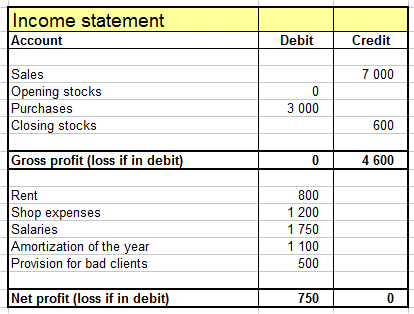
Here we see sales of 7000€ (be they cash or on credit). The COGS were 2400€. The ending stock is 600€, which we already saw in the BS.
And we see the various operational charges incurred to produced the sales. Last year's bottom line was a loss.
In the present cycle, we shall work with the following journal, next to which I added a sheet presenting the evolution of the stock:

This cycle no longer begins with initial money put into the firm by the owners.
We begin the cycle with 600€ of goods. Let's assume that they were purchased at 50€ apiece. So we start with 12 items in stock. We shall keep track of the stock quantity and value and of the COGS using the FIFO method.
Once again, let's stress that we do not purport to illustrate good management, nor very realistic accounts. Our purpose is to show accounting at work.
We can present the accounts, at the beginning of the cycle, using a Trial balance lay-out. It's not much different from the beginning BS, but it may be more convenient to follow the transactions of the cycle:
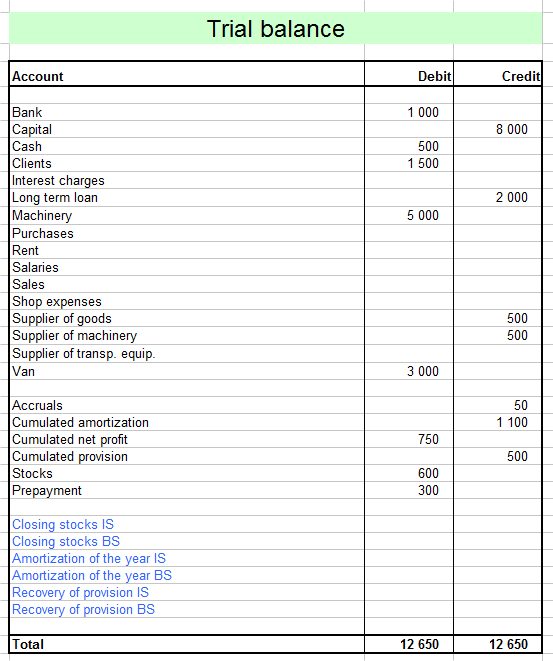
The BS accounts have the ending figures from last year. The IS accounts are empty. And there are no adjustments yet.
Let's record the first transaction of the cycle: purchase of goods on credit 3000€, corresponding to 50 items at 60€ apiece.

and

Notice that the account began with its balance brought down from last year: 500€.
We can also record right away this purchase transaction in an ongoing TB:
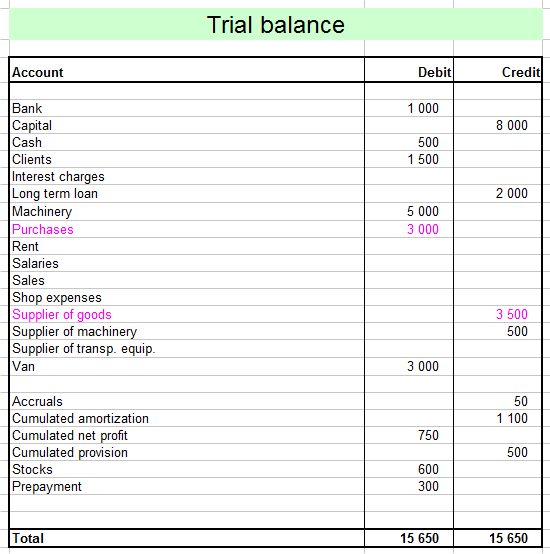
Let's post rent now:
we debit the rent account

and we credit the bank account

Let's see the evolution of the ongoing TB:
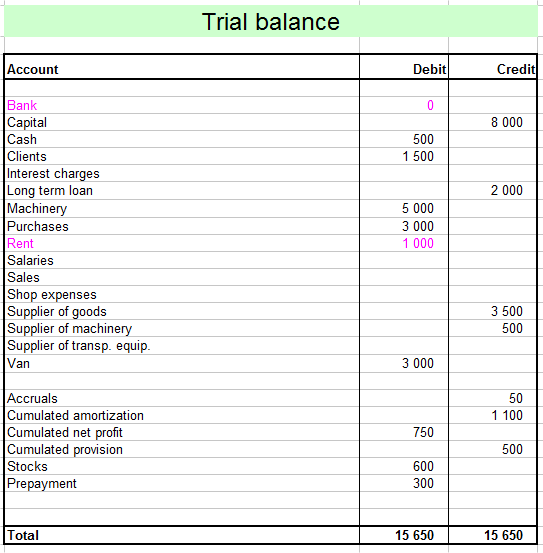
Shop expenses. Now we actually record the consumption of the 300€ worth of shop expenses already paid for last year (be the payment with money or with an IOU), and which were temporarily parked into assets.

and we "cancel" the prepayment:

Impact on the TB:
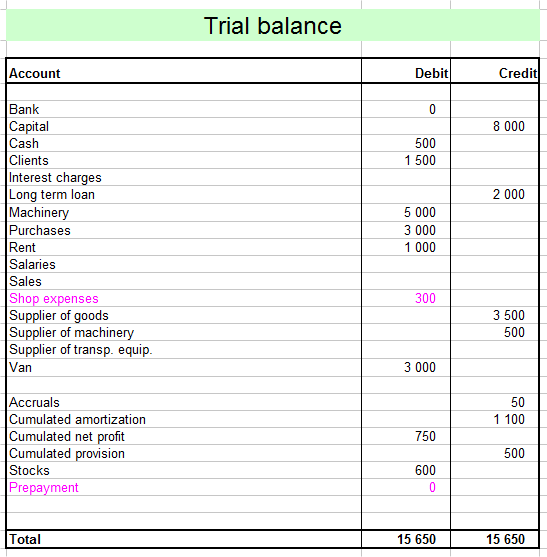
Similarly, now we received the invoice for the accruals, and we settle them with cash
we credit cash:

and we "cancel" accruals:

Impact on the TB:
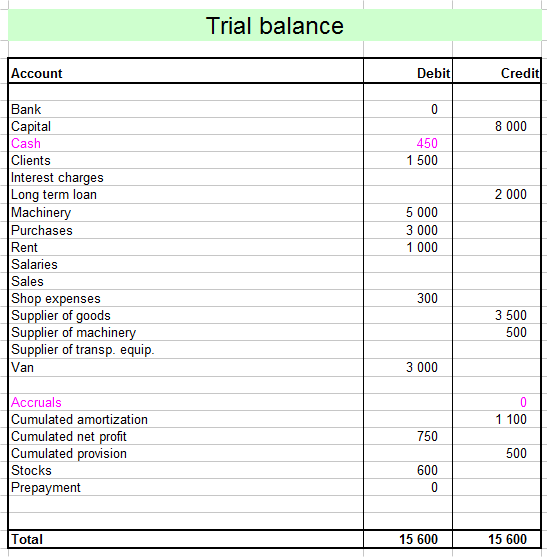
The first sale of the new cycle: we sell 20 items at 200€ apiece. (Our stock goes down from 62 to 42 items.)

and

Impact on TB:
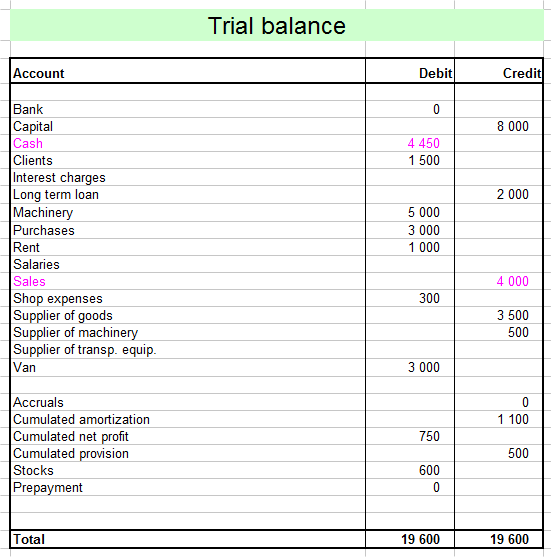
We keep on posting the transactions of the year, debit somewhere, credit elsewhere. And we may follow the impact on the Trial balance: this allows us to check that we make no mistake and that the balance stays balanced.
The next transaction is to take some cash to bank. Impact on the TB:
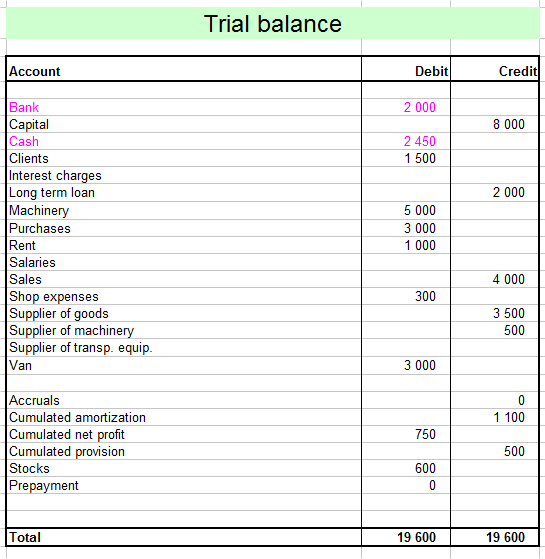
The reader is strongly encouraged to post all the transactions until the end of the journal, and to follow as well the ongoing impact on the Trial balance.
When we're finished posting all the transactions, we get the following TB:
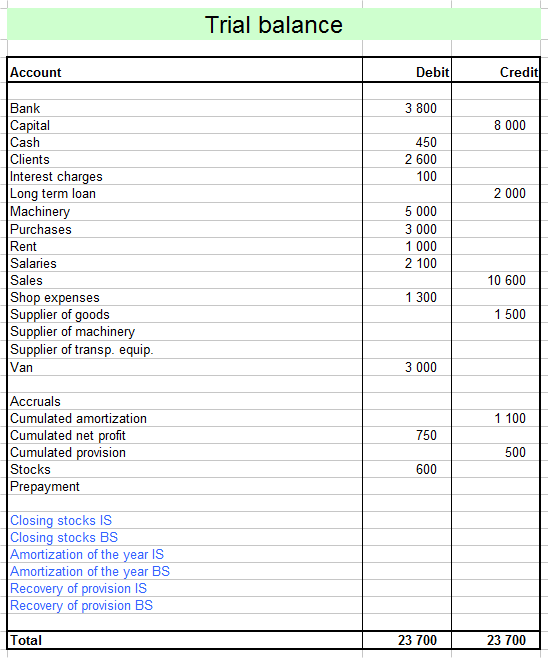
We still have to do some adjustments of the year.
We make adjustments for:
- stocks: the ending stocks are 720€
- amortization of the year: same charge as last year, 1100€
- recovery of provision for a doubtful client who finally paid: we credit a "Recovery of provision IS account", and we debit a "Recovery of provision BS account".
The adjusted balance is:
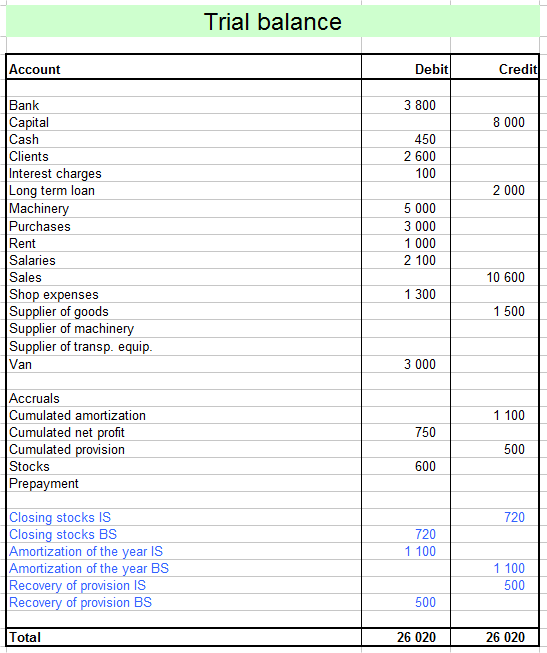
Notice that the effect of the last adjustment, Recovery of provision, is to increase the profit of the year by 500€, and cancel the credit of 500€ we had on the asset side of the BS. These 500€ of provision, recorded last year, had decreased last year profit by the same amount.
In other words, we "moved" 500€ of profit from last year to this year.
It is an example of the margin of choice we have in accounting. When we make abusive use of it, we enter into what's called "creative accounting" (cf. Enron).
In order to keep the example simple, this year I made no adjustments for further provisions or prepayments or accruals.
Extracting the Revenue accounts from the adjusted TB, we get the IS of the year:
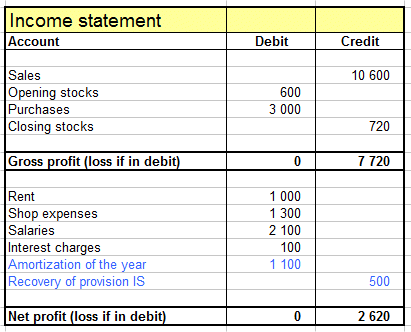
The net profit or loss this year is a profit of 2620€, which in the BS will come in addition to the cumulated past P&L.
Finally here is the BS at the end of the cycle:




